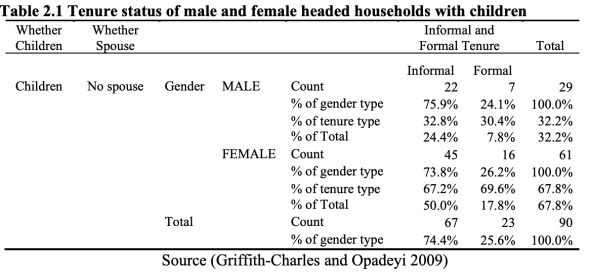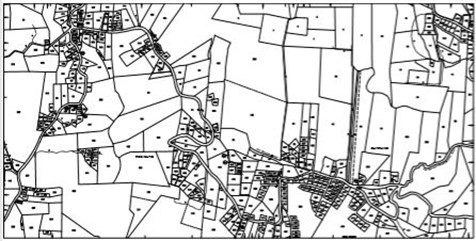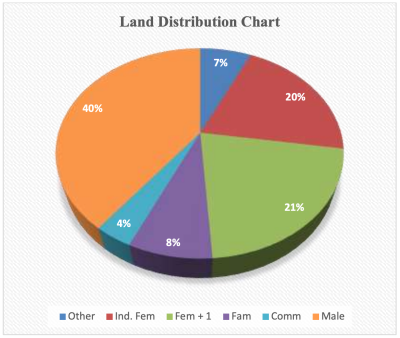Article of the Month - April 2022
|
Use of Global Indicators and Cadastral
Information for Tracking Gender and Tenure Issues in the Caribbean
Charisse GRIFFITH-CHARLES, Trinidad and Tobago
 |
| Charisse Griffith-Charles |
This article in .pdf-format
(18 pages)
The aim of this article is to explore the individual indicators such
as the LANDex with a focus on gender disparities in land tenure.
Sample sets extracted from Sain Lucia's land registration database
were used to exaine whether gender disparity occurs in land tenure
and if so, to what extent it occurs.
SUMMARY
Gender disparity in land tenure is not perceived to be a significant
issue in the Caribbean. However, global indicators usually require some
focus on gender data even though this is not gathered or tracked as a
priority in the region. These standardised global indicators are useful
to benchmark land administration systems one against the other in order
to monitor progress and development, or to evaluate systems for
attainment of specific goals. The Global Land Governance Index or LANDex
is a group of indicators promoted by the International Land Coalition
(ILC) that can be used for benchmarking in this way as well as for
evaluation of countries’ achievements toward the Sustainable Development
Goals (SDGs). The aim of this work was to explore the individual
indicators such as the LANDex with a focus on gender disparities in land
tenure. Sample sets extracted from Saint Lucia’s land registration
database were used to examine whether gender disparity occurs in land
tenure and if so, to what extent it occurs.
Results from the case study indicated that gender disparity in land
tenure does exist to the extent where individual female land owners
owned less than fifty percent of the number of parcels of land that
individual male land owners held. It was noted that the statistic
did not account for scale and culture differences and considerable
additional information was required to fully elaborate on the statistic
as it provided only limited information on the complex situation.
The findings were significant for identifying where these disparities
occurred so that the issue can be placed on the agenda of many Caribbean
countries.
1. INTRODUCTION
Gender and tenure issues are inextricably linked internationally and
result in inequity in rights that impact societies. Gender disparity in
land tenure is not perceived to be a problem in the Caribbean
(Griffith-Charles 2004) as women hold a relatively high level of
empowerment in education, labour, and political spheres. The World
Economic Forum (Crotti et al. 2020) publishes
an annual report on gender gaps in countries of the world. In 2020, The
Bahamas was ranked sixth in the world with Trinidad and Tobago at
twenty-fourth and Barbados at twenty-eighth place. As a result of this
attitude, gender is not always tracked to support or contradict this
perception. There is a need, however, to demonstrate whether or not
there is gender disparity specifically in land tenure so that
interventions aimed at development may be channelled appropriately for
the benefit of the Caribbean societies and so that the incidence may be
benchmarked against other societies. This paper looks at existing sparse
data in a small statistical sample of land ownership in a case study in
Saint Lucia and makes suggestions for addressing this land information
issue.
2. BACKGROUND
Gender imbalance in land rights can affect livelihoods and food
security. Gender in land in Latin America is discussed by Deere and León
(2003) who indicate that there may be several reasons for a disparity to
exist including culture, religion, and tradition as practised in
inheritance, marriage and social processes and relationships. The
disparity itself does not tell the entire story and addressing the
disparity to provide equality may require actions that affect practices
in society leading to loss of deeply held cultural traditions. Acquiring
land by inheritance, for example, may follow patrilineal customs even
though state laws may provide for equality of treatment. At the state
administrative level, addressing disparities may also mean amending or
introducing policies, legislation and institutions for taking action.
Gender information is now required by aid agencies, not only for
establishing and monitoring whether good governance guidelines as
outlined in frameworks such as the Land Governance Assessment Framework
(LGAF) (Deininger, Selod, and Burns 2011) or the Voluntary Guidelines on
Responsible Governance of Tenure (VGGT) (FAO. 2014) are being followed,
but also for reporting on the Sustainable Development Goals (SDGs) as
most countries have committed to so doing. It has been identified that
several of the SDGs have direct links to land and land tenure.
Specifically, the Global Land Tool Network (GLTN) has identified that
SDGs 1, 2, 5, 11, and 15 and their sub-components of 8 targets and 12
indicators, relate directly to land. Gender imbalances in these specific
components may therefore impact the abilities of states to reduce
poverty, which is the focus of the SDGs. This fact is not globally
recognised. The Trinidad and Tobago Voluntary National Report
(Government of the Republic of Trinidad and Tobago 2020), for example,
while including a discussion on gender disparity, does not include the
relationship of gender disparity to land and development and thus the
reduction of poverty that can be effected by interventions in land
tenure.
A study done as a forerunner for implementing adjudication and
titling in Trinidad and Tobago indicated that female land owners were a
vulnerable group in the pending registration project as a purposive
sampling of informal occupation on state land produced a statistic that
73% of the female headed households polled were in informal occupation
(Griffith-Charles and Opadeyi 2009). Table 2.1 shows the details of the
statistic as it presents the breakdown of percentages within female and
male headed single parent households with children who reside on formal
and informal land within the specific sampled areas. It also shows that
67% of the informal parcels are occupied by female headed households as
opposed to 33% for male headed households. It can also mean that
interventions should target female headed households primarily to reach
more families and children in poverty. The land registration process
could put them at a disadvantage if power relations meant that they
could not advance and demand their land rights. It is not perceived that
there are restrictions to women holding land in Trinidad and Tobago as
legislation over the years have sought to address historical inequities.
For example, the Cohabitational Relationship Act No. 30 of 1998
(Republic of Trinidad and Tobago 1998) and the Distribution of Estates
Act No. 28 of 2000 (Republic of Trinidad and Tobago 2000) provided for
women who were in cohabitational relationships and their offspring from
being displaced from the home on the death of their partners. It was
only in 1975 with the Married Persons Act of 1975 (Republic of Trinidad
and Tobago 1976) that married women were allowed personal property that
could be disposed of by them alone (Wylie 2011).

While the Land Settlement Agency (LSA), which is the institution that
manages informal settlements on state land in Trinidad and Tobago,
encourages women to apply for the land they occupy informally, the
inequity is usually an indirect result of other factors such as child
rearing, which reduces the ability to work and to save money for land
purchase for single parents, who are generally female. As quoted in a
study directed at perceptions of tenure security in informal communities
in Trinidad and Tobago (Griffith-Charles 2004, 106), when asked whether
there was gender equality for women in land issues a male respondent
stated:
“Equal! Even a little better. Whereas people will help women you
think anybody would come and help me?”
Although this one quote gives anecdotal evidence of a perception that
women have certain privileges, more rigorous data gathering would be
required to determine the status.
3. METHODOLOGY FOR THE CASE STUDY
Information on land tenure in relation to gender is somewhat sparse
for the Caribbean. This paper uses existing data and publications
related to perceptions surrounding gender and land in a more qualitative
than quantitative assessment of the situation. A small study on Saint
Lucia’s land registry data gives some support to a central idea on the
status of gender and land tenure in the Caribbean. For this work, the
registry data was extracted for a sample area of parcels in an
urban/peri-urban and primarily residential area of Saint Lucia called
Babboneau. Since gender was not an attribute noted on the data in the
land registry, assumptions were made about the gender of the owner from
looking at the name listed as the owner in the land registry records.
Approximately 1030 parcels in the sample area were assessed out of an
estimated 60,000 total parcels for the island. The number of parcels has
been quoted as being 33,000 in 1989 at the end of the systematic
adjudication and titling process and 56,000 in 2002 (Barnes and
Griffith-Charles 2007). The sample therefore only reflects approximately
1 percent of the total number of parcels in the country but should be
reflective of the residential urban/peri-urban parcels in the country.
Figure 3.1 shows one example of the blocks with all the registered
parcels indicated.

Figure 3.1 - Block 1448B mapsheet
The map sheet indicates that in the peri-urban areas of Babonneau,
residential development follows a linear ribbon pattern along the main
roadways with larger agricultural parcels falling behind the residential
plots.
4. RESULTS
From the selected blocks in the urban/peri-urban area of Babonneau,
listed as 1446B, 1448B, 1646B 1647B, 1648B, 1846B, 1848B, 1849B, the
parcel owners were determined to be one of the categories of: individual
female, female plus one other, parcels in common, family land, male, or
other, where the owner was some other entity or corporation. These terms
were therefore defined as:
Individual female – The sole owner of the parcel is female
Fem+1 – One female owner plus one other owner (usually a married couple)
Fam – Family land with multiple owners
In Common – Land owned in common by multiple owners in a company or
business
Individual Male – The sole owner of the parcel is male
Other – The land is owned by the state, church or other institution
Tables 4.1 to 4.8 indicate the numbers of parcels in each category
for each registration block in the land registry while Table 4.9 gives
the total of all blocks. Figure 4.1 shows graphically the relative
percentages of each category to the total number of parcels. The parcels
and percentages in the tables indicate that in each block of parcels,
the number and percentages of parcels when the sole owner is male is
either almost or more than twice that of the number and percentage of
parcels when the sole owner is female. Only in one block is the number
equal when the total number of parcels for that block is too few to be
representative of the norm.
Table 4.1 - Land distribution data for block 1446B

Table 4.2 - Land distribution data for 1448B

Table 4.3 - Land distribution for 1647B

Table 4.4 - Land distribution for 1648B

Table 4.5 - Land distribution for 1846B

Table 4.6 - Land distribution for 1847B

Table 4.7 - Land distribution for 1848B

Table 4.8 - Land distribution for 1849B

Table 4.9 - total land distribution data


Figure 4.1 - Percentage of parcels per tenure ype of the total number
of parcels
5. DISCUSSION
From the statistics it is observed that the percentage of individual
male owners is almost twice the percentage of individual female owners.
The quantitative data, however, does not give the complete picture and
more detailed discussions would tease out the impacts of this disparity
on the security that female land occupants feel. For example, supportive
legislation, where it exists, such as the Cohabitational Relationship
Act No. 30 of 1998 (Republic of Trinidad and Tobago 1998), the
Distribution of Estates Act No. 28 of 2000 (Republic of Trinidad and
Tobago 2000), and the Married Persons Act of 1975 (Republic of Trinidad
and Tobago 1976) protect women’s land rights even where their name is
not on the title document. The LANDex methodology to determine the
perceptions of security require that the respondents answer the
following questions for both urban and rural environments.
Number of female respondents that indicated they were “Not worried at
all” about losing rights to use property in next five years
Number of female respondents that indicated they were “Not worried”
about losing rights to use property in next five years
Number of female respondents that indicated they were “Somewhat worried”
about losing rights to use property in next five years
Number of female respondents that indicated they were “Very worried”
about losing rights to use property in next five years
These questions should be answered in further studies using the
administration of questionnaires to fully explore the perception of
security of tenure that women feel despite the lack of documentary
security of tenure equivalent to that of the males. Land administration
systems in the Caribbean should seek to ensure that gender information
is captured during all land transactions as a part of the standard
procedures.
REFERENCES
- Barnes, Grenville, and C Griffith-Charles. 2007. "Assessing the
formal land market and deformalization of property in St. Lucia."
Land Use Policy 24 (2): 494-501.
- Crotti, Robert, T Geiger, V Ratcheva, and S Zahidi. 2020. Global
Gender Gap Report 2020. World Economic Forum (Cologny Geneva).
- Deere, Carmen Diana, and Magdalena León. 2003. "The gender asset
gap: Land in Latin America." World development 31 (6): 925-947.
- Deininger, Klaus, Harris Selod, and Anthony Burns. 2011. The
Land Governance Assessment Framework: Identifying and monitoring
good practice in the land sector. The World Bank.
- FAO. 2014. Voluntary guidelines on the responsible governance of
tenure of land fisheries and forests in the... context of national
food security. Food & Agriculture Organization of the United Nations
(FAO).
- Government of the Republic of Trinidad and Tobago. 2020.
Voluntary National Review Trinidad and Tobago. Government of the
Republic of Trinidad and Tobago (Port of Spain Trinidad and Tobago).
- Griffith-Charles, Charisse. 2004. "Trinidad:‗ We are not
squatters, we are settlers ‘." In Demystifying the mystery of
capital: Land tenure and poverty in Africa and the Caribbean, edited
by Robert Home and Hilary Lim. London: Glasshouse Press.
- Griffith-Charles, Charisse, and J Opadeyi. 2009. "Anticipating
the impacts of land registration programmes." Survey Review 41
(314): 364-373.
- Republic of Trinidad and Tobago. 1976. Married Persons Act
---. 1998. Cohabitational Relationship Act No. 30 of 1998.
---. 2000. Distribution of Estates Act No 28 of 2000.
- Wylie, John CW. 2011. "Land laws of Trinidad and Tobago."
BIOGRAPHICAL NOTES
Dr Charisse Griffith-Charles Cert. Ed. (UBC), MPhil. (UWI), PhD (UF),
FRICS is currently Senior Lecturer in Cadastral Systems, and Land
Administration in the Department of Geomatics Engineering and Land
Management at the University of the West Indies, St. Augustine, where
her research interests are in land registration systems, land
administration, and communal tenure especially ‘family land’. She is
also Deputy Dean, Faculty of Engineering (UWI). She places importance on
professional membership and is a Fellow of the Royal Institution of
Chartered Surveyors (FRICS) and member of the Institute of Surveyors of
Trinidad and Tobago (ISTT). She has also been President of the ISTT,
President of the Commonwealth Association of Surveying and Land Economy
(CASLE) Atlantic Region, and President of the Fulbright Alumni
Association of Trinidad and Tobago (FAATT). Dr Griffith-Charles has
served as consultant and conducted research on, inter alia, projects to
revise land survey legislation in Trinidad and Tobago, assess the impact
and sustainability of land titling in St. Lucia, address tenure issues
in regularising informal occupants of land, and to assess the
socio-economic impact of land adjudication and registration in Trinidad
and Tobago, apply the STDM to the eastern Caribbean countries, and
document land policy in the Caribbean. Her publications focus on land
registration systems, land administration, cadastral systems, and land
tenure.
CONTACTS
Dr Charisse Griffith-Charles
Department of Geomatics Engineering and Land Management
Faculty of Engineering
The University of the West Indies, St. Augustine
TRINIDAD AND TOBAGO
Phone: +868 662 2002 ext 82520
Website:
https://sta.uwi.edu/eng/dr-charisse-griffith-charles



































